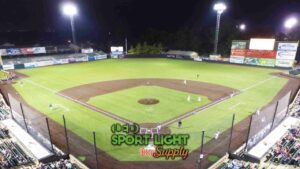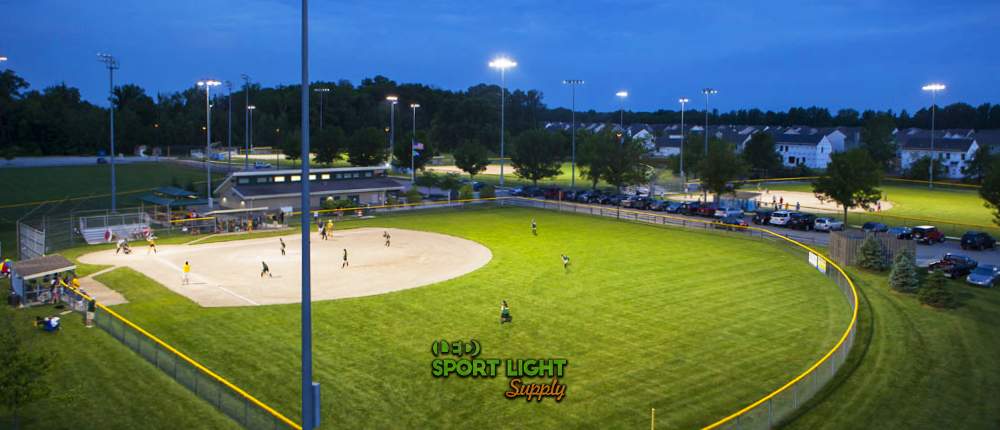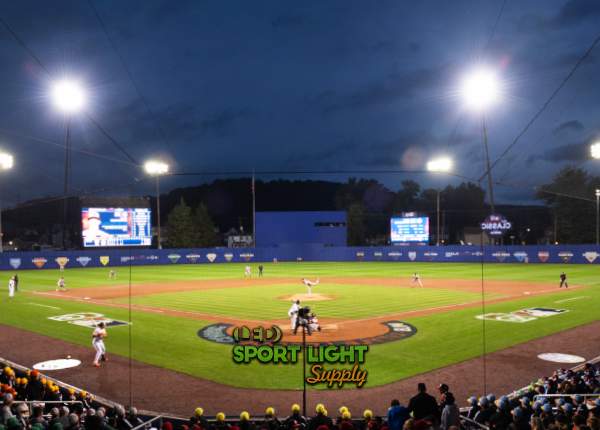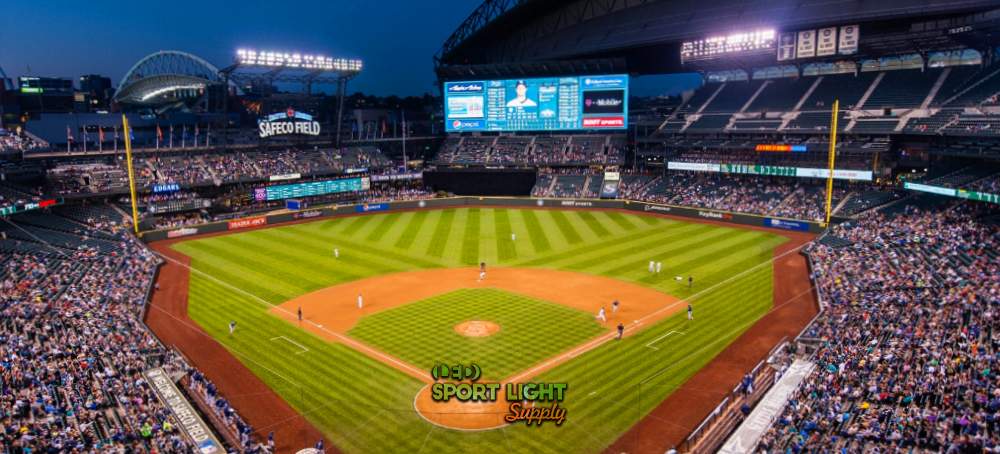
Over the years, technological advancements have led to significant improvements in how baseball fields are illuminated, particularly with the introduction of LED lighting. This shift to LED technology not only brings energy savings and enhanced lighting quality but also addresses concerns like glare, maintenance, and environmental impact.
| Area | Recommended Lux Level | Uniformity Ratio | Explanation |
|---|---|---|---|
| Playing Field (General) | 300 – 500 lux | 0.6 | Ensures adequate brightness for players to see clearly and perform precise actions. |
| Pitcher’s Mound | 500 – 700 lux | 0.7 – 0.8 | Higher lux for precise pitch execution and tracking of the ball. |
| Infield | 300 – 500 lux | 0.7 – 0.8 | Uniform light across bases and field positions, ensuring visibility for players. |
| Outfield | 200 – 300 lux | 0.6 – 0.7 | Sufficient lighting for outfielders to track and catch fly balls. |
| Baseball Stadium (Seating Area) | 150 – 200 lux | 0.4 – 0.6 | Bright enough for spectators to clearly view the game without excessive glare. |
| Bench Area/ Dugout | 150 – 200 lux | 0.6 – 0.7 | Provides visibility while minimizing glare to players and staff. |
Table of Contents
Toggle
The recommended illuminance levels for a professional baseball field fall between 100 and 150 foot-candles (fc), which ensures that the field is adequately lit for both players and spectators. This level of brightness is necessary for clear visibility, allowing players to accurately judge the ball’s speed and trajectory while reducing eye strain for spectators who want to enjoy the game without difficulty. Achieving the proper illuminance level on the playing field not only enhances performance but also makes the experience more enjoyable for everyone involved.
Illuminance levels are determined by the size of the field and the type of game being played. For major league games, higher levels of brightness might be required, especially in larger stadiums or at night, to compensate for the vast area and to maintain optimal visibility under varying weather conditions. The accuracy of lighting systems, particularly with LEDs, ensures that all corners of the field, from the base paths to the outfield, are evenly illuminated.
Uniformity of light distribution is another key aspect that contributes to an optimal playing environment. The uniformity ratio measures how consistently light is spread across the field. For baseball fields, the ideal ratio should be no worse than 2:1, meaning that the average illuminance should not exceed twice the minimum illuminance in any given area of the field. If the uniformity ratio exceeds this, it could result in areas of the field being too dark, creating difficulties for players and impacting their performance.
LED systems are particularly effective in achieving the required uniformity ratio. Their directional lighting capabilities ensure that each area of the field receives a consistent amount of light, whether it’s the infield or the outfield. Unlike traditional systems, which often suffer from uneven distribution due to the shape of the bulbs or reflectors, LED lights are designed to target specific areas with precision, resulting in a more balanced and effective lighting setup.
 Excessive glare from lighting can be one of the biggest hindrances to visibility, affecting players, referees, and spectators alike. Glare occurs when light is scattered or directed in ways that distract or impair the ability to see clearly. In a baseball setting, this can disrupt gameplay, causing players to lose focus or misjudge an incoming pitch. Proper glare control ensures that light is focused on the field where it’s needed, reducing unnecessary spill and minimizing the impact of bright spots that could hinder vision.
Excessive glare from lighting can be one of the biggest hindrances to visibility, affecting players, referees, and spectators alike. Glare occurs when light is scattered or directed in ways that distract or impair the ability to see clearly. In a baseball setting, this can disrupt gameplay, causing players to lose focus or misjudge an incoming pitch. Proper glare control ensures that light is focused on the field where it’s needed, reducing unnecessary spill and minimizing the impact of bright spots that could hinder vision.
LED lights are equipped with advanced optical control features that help minimize glare. Reflectors and diffusers are used to direct the light precisely where it’s needed on the field, ensuring that the light is focused on the players and the playing area while reducing spill into the stands or sky. This precise control also ensures that the surrounding environment is lit sufficiently without creating uncomfortable glare, creating a better experience for everyone involved in the game.
The placement and height of lighting poles are vital for achieving optimal illumination on a baseball field. Typically, poles should be positioned between 70 and 90 feet in height, with spacing between them carefully calculated to ensure an even spread of light. Inadequate pole height or improper placement can lead to uneven lighting, leaving certain parts of the field darker than others.
LED lighting systems offer greater flexibility in pole placement due to their directional nature. Unlike older lighting systems that might require more poles or specialized arrangements to achieve the same effect, LEDs allow for a more strategic alignment, which can improve the efficiency of the setup. This flexibility in design helps meet the required lighting standards without excessive infrastructure or wasteful energy consumption.
Effective field lighting is central to enhancing safety and ensuring that the game can be played without any visual hindrances. With well-designed lighting, the risk of accidents is minimized, as shadows and glare that might cause players to lose track of the ball or misjudge their position are reduced. Proper illumination ensures that every aspect of the game, from the pitcher’s delivery to the outfielder’s fielding, is visible, reducing the likelihood of injuries.
At night or during overcast conditions, quality lighting becomes even more essential. It offers players the opportunity to maintain their focus without distractions, while also creating an enjoyable atmosphere for fans in the stands. This level of performance and enjoyment would be difficult to achieve without adhering to lighting standards that account for visibility and uniformity across the field.
One of the significant advantages of upgrading to LED lighting on baseball fields is energy efficiency. Compared to traditional lighting methods, such as metal halide lamps, LEDs consume much less power, which directly impacts operational costs. LEDs can deliver the same levels of brightness while using up to 50% less energy, making them a cost-effective option for facilities looking to cut down on their electricity bills. This reduction in energy consumption aligns with broader sustainability goals, as less power usage translates to fewer carbon emissions and a reduced environmental footprint.
Moreover, as electricity prices continue to rise, energy-efficient lighting like LEDs provides long-term financial benefits. Facilities can save a considerable amount on their energy bills, which can be reinvested into other areas of the game or the stadium, enhancing the overall fan and player experience.

A key factor in creating an ideal playing environment is the quality of light. Traditional lighting systems often suffer from flickering, inconsistent brightness, or color shifts, which can distract players and diminish their performance. LEDs, on the other hand, offer stable and uniform lighting that remains consistent throughout the game. Whether it’s the bright lights shining down on the pitcher’s mound or the outfield, LED systems ensure that every area of the field is illuminated without any sudden drops in intensity.
This even distribution of light is crucial for baseball, where precision is required. Poor lighting can cause areas of the field to appear darker, making it difficult for players to track the ball or judge distances. With LEDs, the entire field is uniformly lit, enhancing visibility and reducing the risk of mistakes due to poor lighting. This consistency not only benefits the players but also provides a better viewing experience for spectators, who can enjoy the game with less distraction from uneven light levels.
LED fixtures have an impressive lifespan that significantly exceeds that of traditional lighting options. While metal halide lamps may need to be replaced every 1,000 to 2,000 hours of use, LED lights can last up to 150,000 hours or more. This extended longevity reduces the need for frequent replacements, resulting in savings on both labor and materials. This benefit also means less downtime for the field, as there is less need for maintenance or fixture replacements during the playing season.
LED lights are also more resistant to physical impacts and vibrations, which makes them particularly suited to the rugged conditions of outdoor environments. Whether it’s from the wind, rain, or the impact of a flying ball, LEDs are designed to withstand these factors without suffering from wear and tear as traditional systems might. This durability makes LEDs a reliable choice for maintaining consistent performance over time, ensuring that the lights remain operational throughout the season.
LED lights require far less maintenance compared to traditional lighting systems. Their long lifespan and durable construction mean fewer replacements and repairs are necessary, reducing the overall maintenance burden for facilities. However, periodic inspections should still be conducted to ensure that the lights are functioning optimally and to identify any potential issues before they cause problems.
Furthermore, as LED technology continues to advance, upgrading to newer systems can bring further improvements in efficiency and performance. The continual development of LED technology means that baseball fields can benefit from brighter, more energy-efficient systems without having to overhaul their existing infrastructure completely.
The transition to LED technology offers a range of benefits, from energy efficiency and cost savings to superior light quality and durability. LED systems provide consistent brightness, minimize glare, and offer flexibility in their installation, ensuring that every game is played under the best possible conditions. As lighting technology continues to evolve, LED systems will likely remain a preferred choice for baseball fields seeking to enhance their performance while reducing environmental impact.
Drop us a line to receive a free lighting design